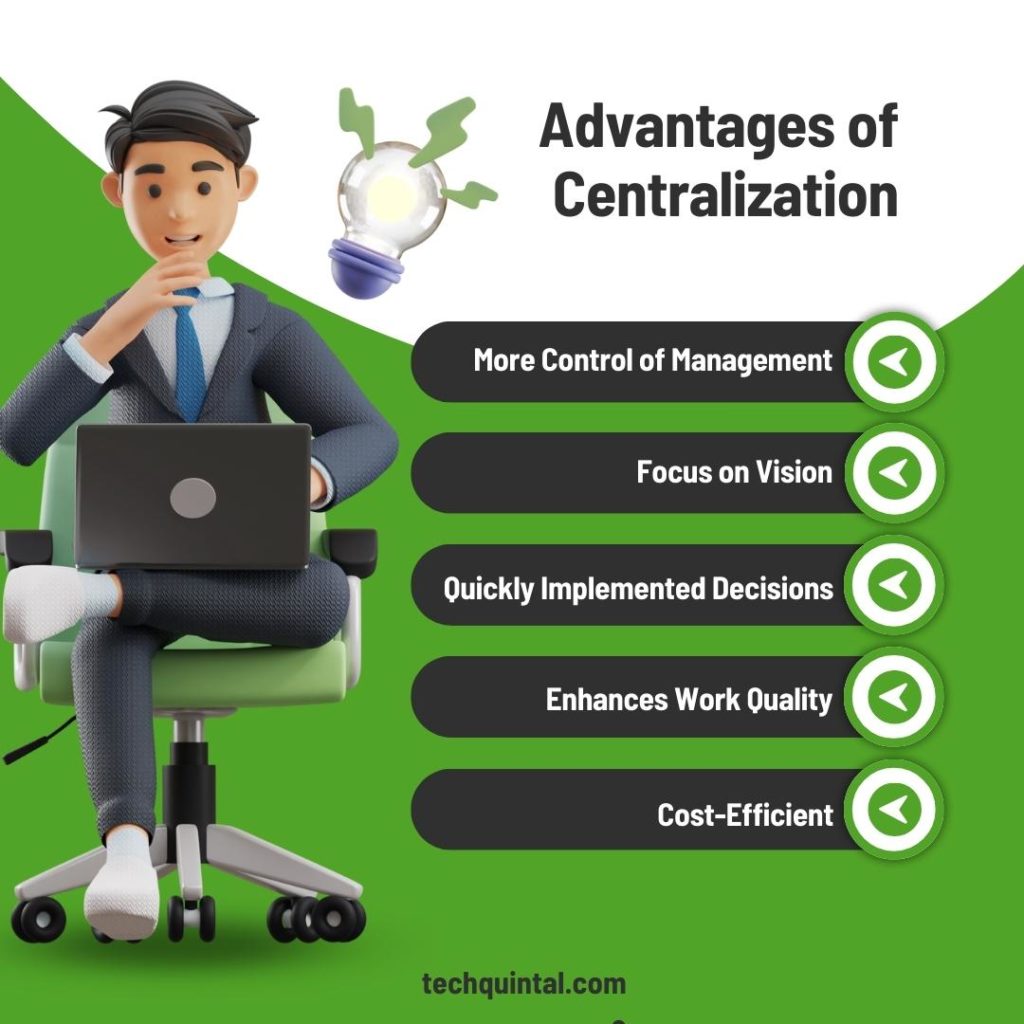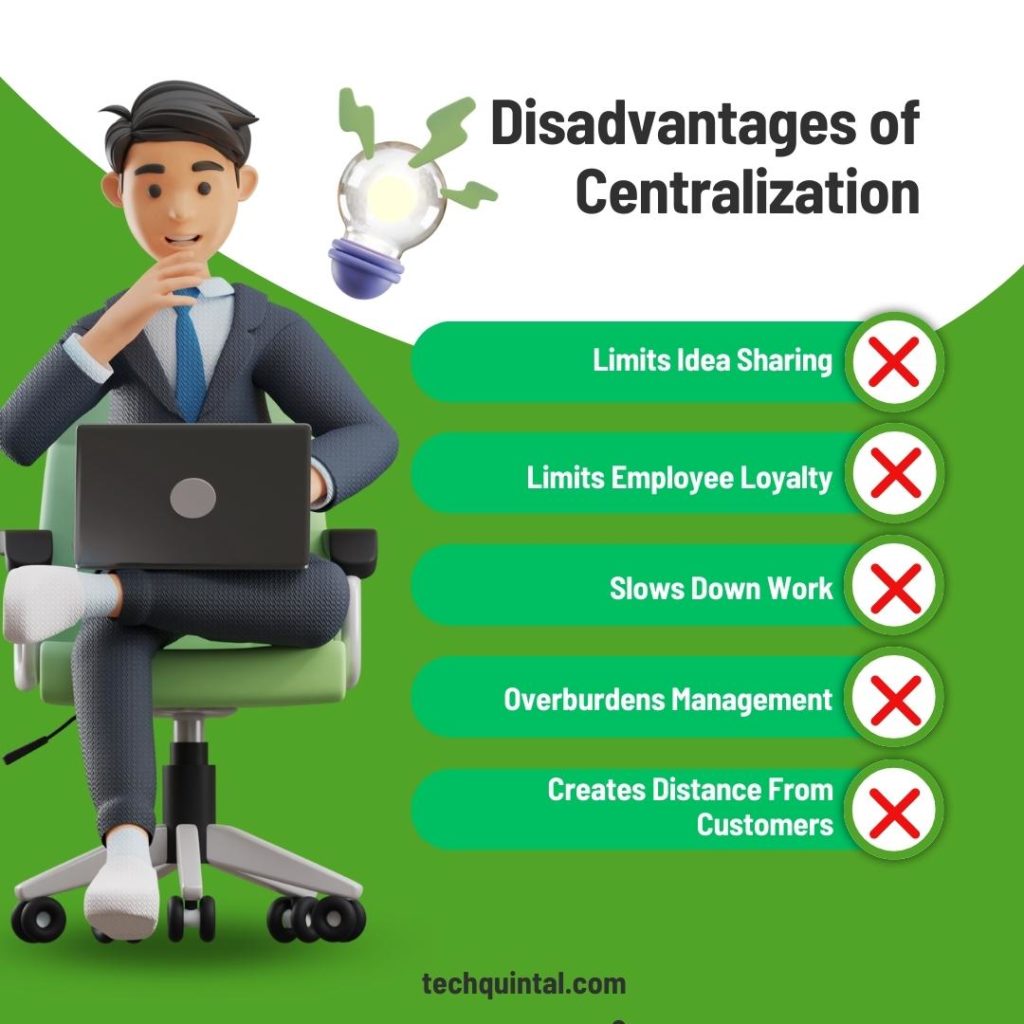
As the term centralization suggests, the authority to make decisions in an organization lies with the top management. Consequently, the actions and decisions on the lower level are dependent on the approval of the top level. For instance, in a centralized organization, the power is retained in the head office, and from there the commands are received by the other offices. There are several reasons firms choose the centralized approach and the foremost one is consistency. Using this system lets the organization maintain cohesion in its products and processes.
Secondly, since the decisions are only made by top management, they align with the objectives and strategy of the organization. Unsurprisingly, there are downsides to this approach that cannot be neglected as it can affect the success of the organization. Therefore, let’s move on to exploring the advantages and disadvantages of centralization.
Advantages of centralization

This system has a clear chain of command, making problem-solving matters easy. The following are other benefits of centralization.
1. Management retains more control
Management makes the most decisions in the centralized organization. The roles and responsibilities of all the employees are clearly defined. This avoids conflict in the work environment. Senior executives are aware of employees’ specialties and accordingly delegate tasks.
In such conditions, junior employees know whom to report to. In other words, entrusting responsibilities makes management confident that there won’t be overlap.
2. Centralization focuses on vision
With centralization comes uniformity. Organizations have various stakeholders including customers and suppliers. The centralized approach ensures that the vision of the organization is uniformly conveyed to all. The lines of communication are clear in centralization, making it easy for management to communicate the vision as well as guide the employees toward achieving it.
3. Decisions are implemented quickly
As we have mentioned earlier, only limited people in a centralized organization have the authority to make decisions. Thus, naturally, this makes the decision-making process quick. In fact, the small group of people involved can easily walk through the implications of each decision and plan a further course of action.
Decisions are reported to the low-level managers, and they have no option but to accept and follow them. Since they cannot provide input, there’s no scope for conflict, making the entire process quick and simple.
4. Centralization enhances work quality
With centralization, the management has control over the operations across the organization. It allows them to ensure that the repetition of tasks is reduced, which conserves the company’s resources. In fact, a centralized organization ensures processes are standardized, resulting in improved work quality. With better supervision, the output is uniform and of high quality.
5. It is cost-efficient
As we have stated above, the recurrence of tasks is decreased in centralization, and so are the associated costs. Along with this, the quality is improved which lowers the costs. Besides, it is not only prices that are saved but also time. The office and administrative costs are reduced with standardized procedures. It eliminates the need for hiring specialties for every department as the responsibility of guiding lies with the headquarters.
Disadvantages of centralization

We have covered the bright side of centralization, but that’s just one part of the story. There is a dark side to centralization, here is a list of some of its downsides.
1. Centralization limits sharing of ideas
In centralization, not everyone gets the equal right to provide their input. The judgments are solely given out by the top management. Considering only a few people are involved in the decision-making for the entire organization, limited creativity can be expected. Therefore, centralization is not suitable for organizations that value creativity.
Also, the lower-level employees are the ones who will carry the tasks out. Therefore, not involving them or their representatives in the judgment-making process might have unforeseen consequences. It is the drawback of centralization that employees are expected to merely follow the instructions and complete the allotted tasks while restricting them from making contributions.
2. It limits employee loyalty
The lack of employee loyalty in the centralized organization comes as no surprise as they are not allowed to take initiative in the work they do. Even though the benefit of centralization is standardization, the risks associated with it are far worse.
For instance, business rigidity and reduced motivation are negative side effects of centralization. With tight control of management, the employees are less likely to suggest deviations and might develop a “why bother” attitude. This reduces the involvement of employees, thereby reducing the scope of innovation.
3. It slows down work
With centralization, it’s just not the creativity and innovation that are at stake, but also the productivity of the employees. Firstly, all decisions are made at the head office, so the other ones must wait to receive and send information. This can slow down the work dramatically as the concerned people might not be available right away.
The process of obtaining approval from the head office can also become lengthy. Therefore, waiting to get guidance for the next projects might make the employees less productive.
4. Centralization overburdens management
As we mentioned above, the management department won’t be available instantly. There can be various reasons for this. First, they are under enormous pressure to formulate conclusions across the organization. Second, they don’t get enough time to oversee the implementation processes of the selected decisions.
Lastly, the management has limited participants. Thus, the overwhelming amount of decision-making requests they receive might lead to findings that are either poorly implemented or considered unsuitable by the employees.
5. It creates a distance from customers
The management level can understand market conditions and make determinations for implementation across the organization. However, the employees on the lower levels are the ones who interact with the customers and are well-versed in their reactions to the products or services.
Considering these employees are not permitted to partake in the process, valuable insights are missed that can otherwise improve products and services significantly. In other words, centralization creates a distance from customers by limiting participation in decision-making.
Centralized or Decentralized: A comparison
| Category | Centralization | Decentralization |
|---|---|---|
| Command Chain | Clear and defined authority with top management. | Shared authority across different levels or departments. |
| Decision Making | Faster as it’s done by top executives. | Slower due to the involvement of various department heads. |
| Innovation | Can be limited due to less employee involvement. | Encouraged due to wider input from various levels/departments. |
| Control | High control over operations and decisions. | Less control as authority and responsibility are spread out. |
| Employee Motivation | Can be lower due to a lack of decision-making power. | Often higher due to increased autonomy and empowerment. |
| Risk Management | Top management absorbs most risks. | Risks are spread out across the organization. |
| Customer Interaction | Limited, as decisions are made at the top. | Greater, as frontline employees have more decision-making power. |
| Costs | Could be lower due to reduced redundancy. | Potential duplication of functions can increase costs. |
| Responsiveness | May be slower because of bureaucratic decision-making. | Faster as local units can respond quickly to their specific situations. |
Summary
Wrapping things up, it’s clear that having a centralized approach to managing an organization has its own set of pros and cons.
The positive side shows us a distinct command chain that not only helps in tackling problems efficiently but also bolsters control for the upper management. Centralization fosters unity through a shared vision, puts decisions into action faster, enhances the quality of work, etc. It can also be a major cost-saver by eliminating repetitive tasks and cutting administrative costs drastically.
On the flip side, centralization tends to limit creativity and idea sharing since the power to make decisions lies mainly with top-tier management. Unsurprisingly, this might dent their loyalty and motivation, resulting in a damper on innovation. Also, it can lead to operational slowdowns, as every decision needs approval from the headquarters.
Should you choose a centralized structure for your company?
When deciding whether to adopt a centralized structure, you, as an organization owner, need to take a step back and carefully weigh the good against the bad. The effectiveness of such a structure will hinge largely on the organization’s unique requirements, objectives, and ethos. So, there is no sweet spot.